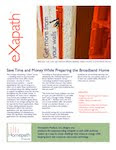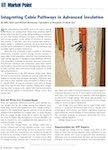With this experiment, Google is giving incumbent ISP’s like AT&T, Qwest, Comcast, Cox and others a significant nudge in the direction of better, faster, richer, open internet service provision. A broadband notion that has been hotly debated but otherwise constipated for decades.
What This Could Mean For Us
The Google experiment targets between 50,000 and 500,000 people in the US with internet speeds of 1,000 Mbps (1Gigabit per second - 1Gbps)...roughly 100 times faster than most internet subscribers receive today...promising a reasonable price. From the announcement, Google divulges three key elements to their initiative. In their words:
- Next generation apps: Google wants to see what developers and users can do with ultra high-speeds, whether it's creating new bandwidth-intensive "killer apps" and services, or other uses we can't yet imagine.
- New deployment techniques: They will test new ways to build fiber networks, and to help inform and support deployments elsewhere, they will share key lessons learned with the world.
- Openness and choice: They will operate an "open access" network, giving users the choice of multiple service providers.
This is really powerful stuff...it places the traditional incumbent ISP business model of slow cable plant deployment with glacial and expensive ratcheting up of internet speeds in peril. Google’s stance will certainly turn heads and cause sleepless nights for those milking the US customer base for cash while the rest of the globe surges ahead in the bandwidth race.
Google mentions several “killer apps” in their blog including the ability to transfer full length BluRay movie files in under five minutes...enabled by 1 Gbps transfer speeds. Astonishingly fast relative to current DSL and Cable Modem ISP rates.
If we look at what else is happening in the world of technology the story becomes more interesting.
Enabling Technologies
A recent post, “Light Peak and You”, discussed Intel and their activity with emerging “Light Peak” optical technology. Intel is making fundamental changes to optical circuitry that promise orders of magnitude cost reduction compared to similar telecommunications grade devices.
Why is this a big deal?
Well, you may not recall when USB crept into every computer and peripheral...we hardly noticed it...but all now use USB and benefit as a result. “Light Peak” has the potential to do the same but with orders of magnitude performance enhancement and far greater physical reach. A game changer.
These advancements enable extremely fast data transfer between devices with greater distances (300 feet) than the latest in USB, version 3.0. The new chips are tiny with projected costs low enough to make sense in consumer electronics.
Remarkable performance. The Intel products will enter the market with speeds of 10Gbps and scale to 100Gbps within ten years. Targeting spaces within the home or office, that’s ten to one-hundred times faster than the transmission rates predicted by Google for long haul applications. Comparing these speeds with that of Google’s ISP plan suggests file transfer of the same BluRay sized files in seconds...not minutes.
What isn’t obvious is that the optical fiber Google relies upon for the long haul (intercity and directly to the home )applications is capable of similar speeds...by simply adding high speed transmitting/receiving equipment at the ends of the links. Therefore it’s conceivable to have similar speed on the Google network feeding incredibly rich content, on demand, across great distances, anywhere. Consumer choice.
Connecting the dots
Rumor mills are rife with suggestions that both Sony and Apple are courting Intel and the soon-to-be-released “Light Peak” chips...suggesting that their consumer electronics will soon offer staggering performance.
Lots to think about...lots going on in the world of technology. Some questions to mull over:
- Is it a coincidence that 3D-HD (larger files than traditional BluRay) was all the rage at the recent Consumer Electronics Show? A technically savvy way to solve digital rights management hurdles and an astounding development for consumers to bring into the home.
- How rapid is global data growth? The Data Deluge: Economist.com
- How about Apple’s new iPad...a neat little handheld computer with a killer high resolution screen...what would it take to add a new “Light Peak” chip inside?
- Would adding new chips to the Apple line of iMac and other desktop computers with cinema quality monitors be too difficult?
- Sony? Well, they know a thing or two about high definition television...3D-HD production...and distribution of content.
- NetFlix? They’re pioneering efforts to stream HD content...but limited by long-haul bandwidth. Still, they’re preparing to shift away from the mail order model toward more immediate gratification and value? Can 3D-HD be far behind?
- Let's not forget Wal-Mart's recent announcement about the acquisition of Vudu...the web based HD movie streaming service...that'll require some pretty heavy bandwidth and high data rates.
- NetFlix, Wal-Mart, Amazon, Apple, Hulu, Vudu, Lala, Blockbuster...streaming HD video battle lines forming - all will require massive broadban
- CISCO's Big Announcement? A New Backbone Router for ISP's
- Anne Eisenberg - NYTimes - An Express Lane from Camera to Computer
There are certainly more examples to raise...more dots to connect...but the same conclusion remains. In the end it comes down to an accelerating need for more bandwidth...bigger, faster pipes to carry rapidly expanding volumes of information...in the long-haul...and within the home.
Google’s project gets at removing a recognized bottleneck in the long-haul networks and encourages traditional players to accelerate their efforts. Once improved, the bottleneck itself will shift from outside to inside the home or building. It seems Intel is preparing for this with “Light Peak” and I suspect their direct customers (consumer electronics suppliers) will quickly follow suit. Ultimately, this means wiring upgrades within the home for applications we can’t even envision today. Evolution.
Are you familiar with the new eXapath™ system from Homepath Products?
Coincidence...or convergence?
The observations and opinions herein are that of the author, cofounder of Homepath Products LLC...with admiration for but otherwise no affiliation with any of the companies mentioned.

























.jpg)

